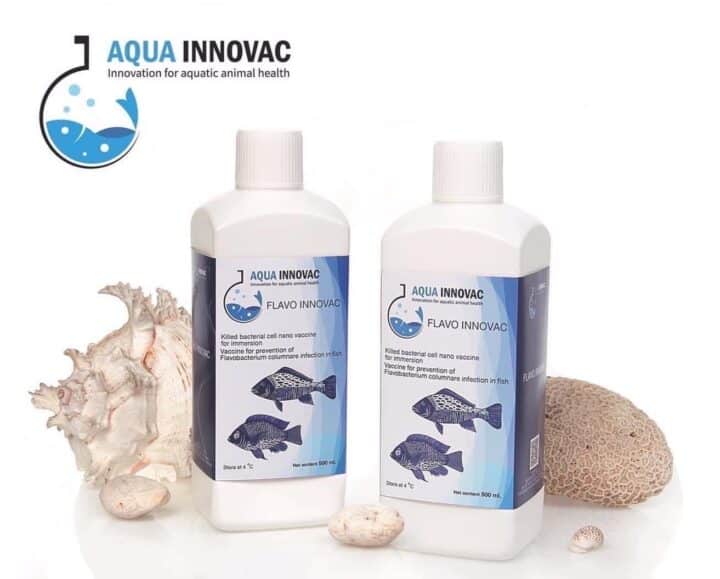The instructor and research team of the Chulalongkorn University Faculty of Veterinary Medicine developed a “Flavo Innovac” dipping nanovaccine for tilapia and sea bass. Reduce disease mortality and limit the need for syringes.

Tilapia and sea bass are popular fish for consumers. But keeping these fish healthy and disease-free is a serious concern for farmers. especially with the epidemic problem caused by flavobacterium bacteria. (Flavobacterium spp.) Which abound in water sources in general. Especially when the number of fish in the pond or cage is crowded. Germs will spread faster. As a result, the fish suffers from gill rot – alkali. they affect the respiratory tract until death which in the worst case is the dead fish that raised the pond.
This is why Associate Professor Dr. Channarong Rodkham, Lecturer at Chulalongkorn University Veterinary Medicine Faculty. Therefore, in collaboration with the research team of Aqua Innovac, he invents the innovation of “Flavo Innovac”, the first inactivated vaccine in the world. which prevents flavobacteria by using nanotechnology as a delivery system
“Usually in the fishery or aquaculture industry, there are infectious diseases in the water culture process. If farmers keep fish too densely bad environment poor water quality more organic change in water temperature Fish are weak and easily infected. Furthermore, flavobacteria are the main pathogens that attack fish. It causes rotten gills, alkaline skin, causing loss and a death rate of over 70%, especially in young fish that are still weak. Prevention can also be done by vaccinating the fish, ”said Prof. Dr. Channarong of the Association.
Why should fish be vaccinated in water?
If you think about the vaccine People tend to think about using a syringe. But using syringes on fish is different from people. including the procedures, costs, as well as the limitations and disadvantages caused by the use of needles, also the risks of using syringes
Assoc. Prof. Dr. Channarong, MD. He explains the fish vaccination process using a syringe. “We can’t inject the fish right away because the fish will fight. As a result, the fish can be stressed, so the injection of the fish is necessary to stun the fish first. Bathing the fish in water mixed with anesthesia. Subsequently, the fish will be vaccinated one by one. having a specialist to inject and also need to use a system to transport the vaccinated fish into the pond. All of these things are paid for, increasing the cost ”.
“In addition to vaccinating the fish, there is a risk that the fish will get infected with other infections in the water due to needle injuries. There is also a limitation that we cannot vaccinate very small fish. This small fish is a group. at very high risk of infection “.
Subcutaneous vaccination has therefore become an alternative to injectable vaccination. The use of infusion vaccines can effectively boost fish immunity. low cost of vaccination And can vaccinate hundreds of thousands and millions of fish at a time, said Prof. Dr. Channarong of the Association.
“For infusion vaccines Farmers can do this easily by immersing the fish in vaccinated water according to the proportions indicated on the label. It takes about 30 minutes, with oxygen being given to the fish while the vaccine is constantly immersed. Then drop the vaccinated fish into the pond or cage. In addition, the nanovaccine against gingivitis is composed of flavobacteria. A species isolated from the local area of Thailand itself. Therefore, it provides good protection against flavobacteria disease in Thailand. “
Nanotechnology vaccine delivery system
The Nano Flavo Innovac vaccine is not only the first fish vaccine in Thailand. It is the world’s first inactivated vaccine against flavobacteria that uses nanotechnology as a delivery system.
“Innovative nanotechnology helps encapsulate vaccines or antigens. When the fish have been immersed in a positively charged nanovaccine. The vaccine will be able to attach itself to the mucous membranes. of fish, which also have a negative charge Then the organic nanoparticles will gradually Release antigens to continuously stimulate the immune system of the fish. When all the antigens are released, the organic nanoparticles will gradually decay in a short time no residue is safe for fish, the environment and consumers. “
Demonstrate the effect of the Flavo Innovac vaccine in field research.
Currently, the innovation of the Flavo Innovac vaccine is in the field of research and development. and evaluation of marketing results A group of farmers have already used the vaccine to test it. had good enough feedback It can actually reduce fish loss from flavobacteria infection.
“The duration of the vaccine to prevent infection is approximately 2 – 3 months over a total fish farming cycle of 6 – 9 months. Although the duration of protection is relatively short, the first 3 months are when the fish are young enough. . There is a high risk of infection. Immunization of the young fish during this period is therefore an important factor for the survival of the fish in the later stage which is more resistant to this infectious disease. “
Prevention of epidemics is of the utmost importance.
Prof. Assoc. Dr. Channarong said health checks are needed before putting fish in ponds. Also, vaccinating fish at a time when the fish are still young will help reduce fish loss in the pond. farming This will allow fish farming to be extended to the wholesale market stage.
“In addition to vaccinating the fish Another important thing every fish farmer should do is submit a batch of fish samples for screening in the laboratory. The Faculty of Veterinary Medicine, Chulalongkorn University and the Department of Fisheries also provide services in this section. To check whether purchased and reared fish pups are infected with this or any other disease. came first? that if any fish infected Before vaccination, it can greatly affect vaccination. Or it could cause the vaccination to fail at that moment ”.
The development of Innovac’s innovative flavo vaccine has received support from many industries, including Chulalongkorn University and the National Research Bureau (NRCT). Supported by the Chulalongkorn University Industrial Technology Research and Development Center (Chulalongkorn University Technology Center: UTC), which in the next step The research team plans to develop a booster (booster) vaccine that is administered in combination with food . so that farmers can stimulate the landscape to make fish more comfortable and easy
In addition to the innovative vaccine against flavobacteria, Aqua Innovac also has an idea to develop a vaccine against other bacteria. affecting the culture of tilapia and sea bass And there are other innovations such as the nano-anesthetic for fish. Supplements for ornamental fish, etc.
Farmers and companies interested in participating in field research and development can contact the Assoc. Prof. Dr. Channarong at [email protected] email.



